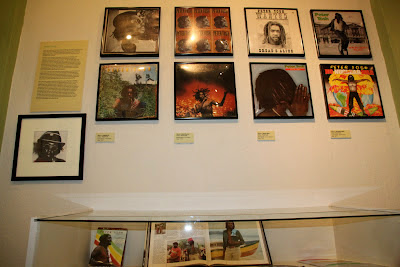'Walk And Don't Look Back'
Drumbeats,
guitar strings and strong vocals encapsulate history of Jamaica
Published August 19, 2012
Sunday Gleaner
This is a narrative
of Jamaica told on a musical crescendo, no bungarung just the words of Jah. Equal Rights: Reggae and
Social Change, is seeking to transform the bare walls
of the Jamaica Music Museum stringing notes of this truly Jamaican genre.
“Since reggae is Jamaican, we have used it to convey the message,” informed Herbie
Miller, director/curator of the Jamaica Music Museum.
“It is a journey highlighting socio-political and spiritual sensibility.”
The
edifice of the museum, housed in downtown Kingston, has been sprinkled with
framed album covers and posters, which chronicles a phase of the island’s
history.
The
exhibition, Miller informed, has been inspired by the late Peter Tosh’s 1997
album titled, Equal Rights and traces the phenomenal power that music
has had over the Jamaican people, since the 16th century.
“Cover
art speaks visually, giving sight to the cultural information in the music.
“What we
see are album covers and what the music they enwrap.”
The
journey of the time capsule beings with the ‘Cult’ music covers, Bongo, Backra,
Coolie, reminiscence from the colonial era, with black and white photos of the master
with the plantation workers. This makes transition to the Mento, workers in
clockwork precision beats coupled with metal hitting the stones as they
sweated, poured their heart and soul out as they worked in the tropical sun.
From the
retro photos the musical voyage moves to caricatures, which is an amalgamation
of stereotypical but creatively done artwork. “This is the time where the
people are being seen from the white (man) eyes, pouted lips, pearly white
grin, seductress poses, it gives the message to come to Jamaica,” said Miller.
The realm
of the ‘happy go lucky’ Jamaica transitions to Ska depicting plain and modern
art building the crescendo of social change as the legendary Bob Marley and the
Wailers resonate ‘Get Up Stand Up’, evolution of musicians on the frontline of
social change.
The walk
in gallery, the visitor is presented with intertwine of memorabilia from
different genre of Jamaica’s musical history. The exhibits which are spread
across two rooms, have Miss Lou as a focal point, exemplifying the matriarch
who paved way for women in music, depicted by album covers of Rita Marley,
Marcia Griffiths adorning the wall.
“We are
looking to the arts as a primary source of history,” Miller said. “And music
marks one of those moments in history.”
Equal Rights: Reggae
and Social Change strives to, in a nutshell, highlight the richness, greatness and the
worldwide appeal of Jamaican music, peaking in all its glory spreading the
message…One Love!
-------------------------------------------------------------------------------
The
Jamaica Music Museum, which is a division within the Institute of Jamaica, is
the archive, research facility and exhibition space for Reggae and other
Jamaican musical forms. The museum
showcases an array of formats from rare musical recordings and oral histories
of reggae, Jamaican music greats and the lesser known figures to musical
scores, photographs, films, research files, business records, personal
correspondence and musical instruments that belonged to eminent Jamaican
musicians.
"Equal Rights: Reggae and Social
Change" forms a part of the Jamaica
50 celebrations is being held at Waterlane Gallery and goes on till August 5,
2013. For more information contact Institute of Jamaica, 10 -16 East Street,
Kingston, Phone: 1-876-922-0620.









Comments
Post a Comment